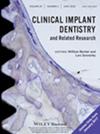Accuracy of Robotic Computer-Assisted Implant Surgery for Transcrestal Sinus Floor Elevation: A Retrospective Case Series Study
Abstract
Aim
To investigate the accuracy of robotic computer-assisted implant surgery (r-CAIS) for transcrestal sinus floor elevation (TSFE) with simultaneous implant placement.
Materials and Methods
Virtual sinus elevation and a stepwise drilling plan were created on the robotic operating system before surgery. Robotic arm automatically executed drilling tasks during procedure. Fourteen implants in ten patients with missing teeth in the posterior maxilla were placed by robotic computer-assisted implant surgery through TSFE. Deviations between the planned and placed implants were evaluated with an immediate postoperative CBCT scan. The coronal, apical, and angular deviations between the planned and actual implant placement were measured.
Results
A total of 10 patients with edentulism in the posterior maxilla were included, and 14 implants were placed. The robot-assisted TSFE with simultaneous implant surgery exhibited a mean global coronal deviation of 0.72 mm (range: 0.32–1.57 mm, 95% CI: 0.52–0.92 mm), a mean global apical deviation of 0.78 mm (range: 0.33–1.50 mm, 95% CI: 0.60–0.96 mm), and an angular deviation of 2.20° (range: 0.16°–8.70°, 95% CI: 0.82°–3.60°), respectively. Throughout the surgical intervention, no immediate or significant complications were noted, and no evidence of complications such as tissue perforation or premature implantation failure was documented in the postoperative phase.
Conclusions
The r-CAIS-assisted TSFE demonstrated potential techniques for implant osteotomy and placement. Nevertheless, further clinical trials are necessary to reinforce evidence-based clinical outcomes.

 求助内容:
求助内容: 应助结果提醒方式:
应助结果提醒方式:


